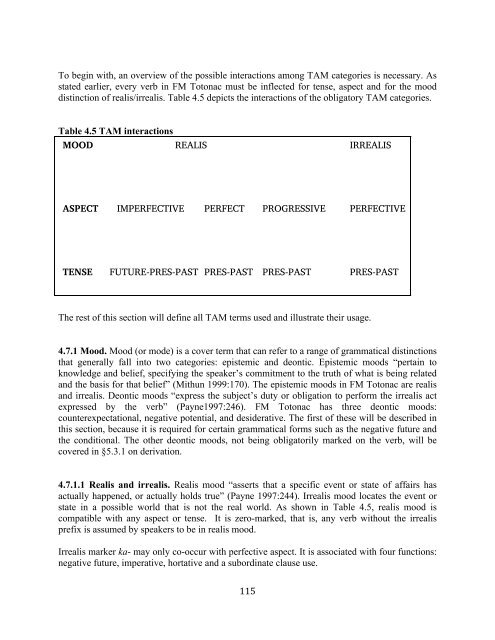The phonology and morphology of Filomeno Mata Totonac
The phonology and morphology of Filomeno Mata Totonac
The phonology and morphology of Filomeno Mata Totonac
Create successful ePaper yourself
Turn your PDF publications into a flip-book with our unique Google optimized e-Paper software.
To begin with, an overview <strong>of</strong> the possible interactions among TAM categories is necessary. As<br />
stated earlier, every verb in FM <strong>Totonac</strong> must be inflected for tense, aspect <strong>and</strong> for the mood<br />
distinction <strong>of</strong> realis/irrealis. Table 4.5 depicts the interactions <strong>of</strong> the obligatory TAM categories.<br />
Table 4.5 TAM interactions<br />
MOOD REALIS IRREALIS<br />
ASPECT IMPERFECTIVE PERFECT PROGRESSIVE PERFECTIVE<br />
TENSE FUTURE-PRES-PAST PRES-PAST PRES-PAST PRES-PAST<br />
<strong>The</strong> rest <strong>of</strong> this section will define all TAM terms used <strong>and</strong> illustrate their usage.<br />
4.7.1 Mood. Mood (or mode) is a cover term that can refer to a range <strong>of</strong> grammatical distinctions<br />
that generally fall into two categories: epistemic <strong>and</strong> deontic. Epistemic moods “pertain to<br />
knowledge <strong>and</strong> belief, specifying the speaker’s commitment to the truth <strong>of</strong> what is being related<br />
<strong>and</strong> the basis for that belief” (Mithun 1999:170). <strong>The</strong> epistemic moods in FM <strong>Totonac</strong> are realis<br />
<strong>and</strong> irrealis. Deontic moods “express the subject’s duty or obligation to perform the irrealis act<br />
expressed by the verb” (Payne1997:246). FM <strong>Totonac</strong> has three deontic moods:<br />
counterexpectational, negative potential, <strong>and</strong> desiderative. <strong>The</strong> first <strong>of</strong> these will be described in<br />
this section, because it is required for certain grammatical forms such as the negative future <strong>and</strong><br />
the conditional. <strong>The</strong> other deontic moods, not being obligatorily marked on the verb, will be<br />
covered in §5.3.1 on derivation.<br />
4.7.1.1 Realis <strong>and</strong> irrealis. Realis mood “asserts that a specific event or state <strong>of</strong> affairs has<br />
actually happened, or actually holds true” (Payne 1997:244). Irrealis mood locates the event or<br />
state in a possible world that is not the real world. As shown in Table 4.5, realis mood is<br />
compatible with any aspect or tense. It is zero-marked, that is, any verb without the irrealis<br />
prefix is assumed by speakers to be in realis mood.<br />
Irrealis marker ka- may only co-occur with perfective aspect. It is associated with four functions:<br />
negative future, imperative, hortative <strong>and</strong> a subordinate clause use.<br />
! "")!

















